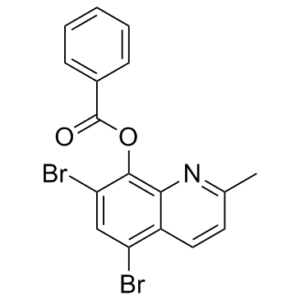This product is for research use only, not for human use. We do not sell to patients.

| Size | Price | Stock |
|---|---|---|
| 250mg | $420 | Check With Us |
| 500mg | $630 | Check With Us |
| 1g | $945 | Check With Us |
Cat #: V3211 CAS #: 3684-46-6 Purity ≥ 98%
Description: Broxaldine is an antiprotozoal drug that can also be used in the treatment of leprosy. It was formerly given by mouth, with broxyquinoline, in the treatment of intestinal protozoal infections, including amoebiasis, but less toxic drugs are preferred. It has an InChI of 1S/C17H11Br2NO2/c1-10-7-8-12-13(18)9-14(19)16(15(12)20-10)22-17(21)11-5-3-2-4-6-11/h2-9H,1H3; and InChI KEY of IJTPLVAAROHGGB-UHFFFAOYSA-N; SMILES Code of CC1=NC2=C(C=C1)C(=CC(=C2OC(=O)C3=CC=CC=C3)Br)Br; Chemical/IUPAC name of (5,7-dibromo-2-methylquinolin-8-yl) benzoate.
Publications Citing InvivoChem Products
Product Promise

- Physicochemical and Storage Information
- Protocol
- Related Biological Data
- Stock Solution Preparation
- Quality Control Documentation
| Molecular Weight (MW) | 421.08 |
|---|---|
| Molecular Formula | C₁₇H₁₁Br₂NO₂ |
| CAS No. | 3684-46-6 |
| Storage | -20℃ for 3 years in powder formr |
| -80℃ for 2 years in solvent | |
| Solubility In Vitro | DMSO: >10mMr |
| Water: N/Ar | |
| Ethanol: N/A | |
| SMILES Code | CC1=NC2=C(OC(C3=CC=CC=C3)=O)C(Br)=CC(Br)=C2C=C1 |
| Synonyms | Brobenzoxaldine; AL 307; AL-307; AL307 |
| Protocol | In Vitro | In vitro activity: Kinase Assay: Cell Assay: |
|---|
| Solvent volume to be added | Mass (the weight of a compound) | |||
|---|---|---|---|---|
| Mother liquor concentration | 1mg | 5mg | 10mg | 20mg |
| 1mM | 2.3748 mL | 11.8742 mL | 23.7485 mL | 47.4969 mL |
| 5mM | 0.4750 mL | 2.3748 mL | 4.7497 mL | 9.4994 mL |
| 10mM | 0.2375 mL | 1.1874 mL | 2.3748 mL | 4.7497 mL |
| 20mM | 0.1187 mL | 0.5937 mL | 1.1874 mL | 2.3748 mL |
This equation is commonly abbreviated as: C1 V1 = C2 V2
- (1) Please be sure that the solution is clear before the addition of next solvent. Dissolution methods like vortex, ultrasound or warming and heat may be used to aid dissolving.
- (2) Be sure to add the solvent(s) in order.




































